We have 15 small boats and certainly didn’t need another one, but in talking with Maynard Bray, WoodenBoat’s Technical Editor, about the best options for small boats that families could build together as well as for introducing our granddaughter to boats, he said, “You should build her a Nutshell Pram.” That planted the idea in our heads, and we bought the plans, to look them over. When we got bored this past winter, we decided to build the little Nutshell. We’re very happy that we did.
The Nutshell was designed in 1983 by naval architect Joel White. “This little packet,” he wrote, “grew out of a discussion with Jon Wilson and Maynard Bray over the winter about why so many designs for plywood boats are complicated, unattractive, and unsuccessful.” He emerged from the conversation with Maynard and Jon, WoodenBoat’s founder, to design a good-looking pram that would be easy to build with 8′ plywood sheets, consisting of only 27 parts for the rowboat version. Joel built the first of the prams, and almost four decades later Maynard still has the prototype and Jon’s family still has the first production model.
Although kits are available, we chose to build our Nutshell from scratch using the plans and Maynard’s 1987 book, Building the Nutshell Pram, as our guide. Its 32 pages guide the builder through the steps of putting the pram together as well as rigging information for the sailboat model and sailing tips. The Nutshell’s glued lapstrake construction offers tremendous strength to the hull and ease of construction, and the traditional pram shape brings out the attribute of workboat utility.
The pram is 7′ 7″ long and 4′ wide, making it small and portable. It was designed as a tender, one that would row, tow, scull, and sail. And at 90 lbs it is light enough to haul up on a mothership’s deck where it would take up very little space.
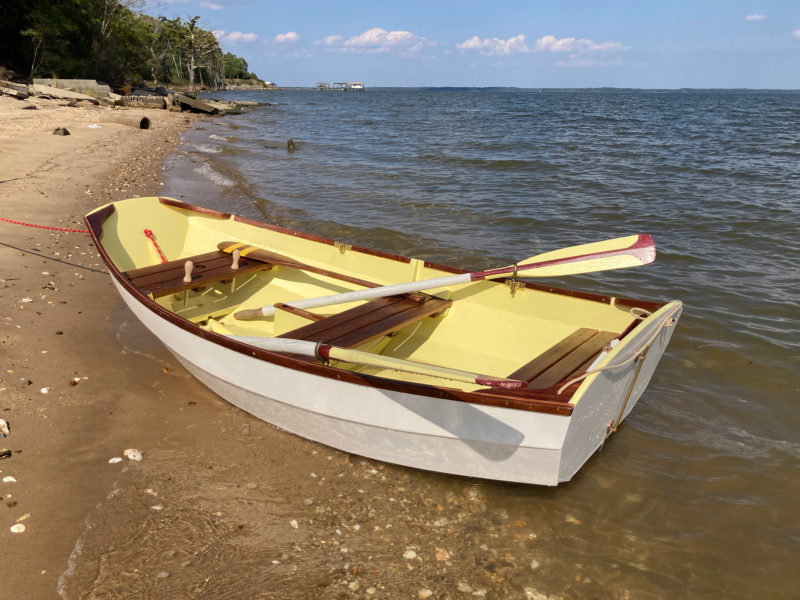 Photo by Audrey and Kent Lewis
Photo by Audrey and Kent Lewis The belaying pins on the forward thwart serve to belay the halyard. While they may seem more sentimental than practical, when properly used they can be pulled in an instant to drop the sail. And unlike cleats screwed in place, they can be removed to clear the thwart for rowing. For builders who don’t have a lathe, they’re available for purchase. The function of the long pintle on the transom is explained in the text.
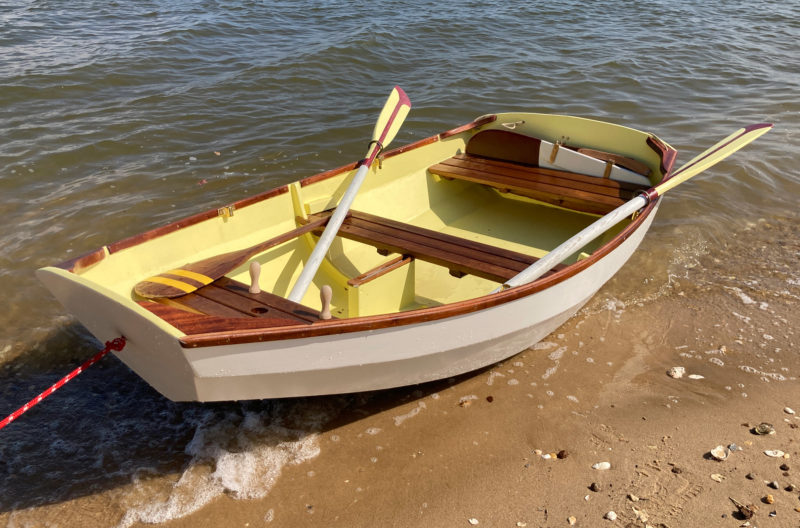 Photo by Audrey and Kent Lewis
Photo by Audrey and Kent LewisFor rowing, the daggerboard, rudder, and tiller fit neatly behind the aft thwart. The lug sail can be rolled up around the spars and laid in the boat; the 8′ 3″ mast will extend past the transom.
The 28″-wide flat bottom and hard chine provide reassuring stability when stepping into and out of the Nutshell. A pair of 6′ oars are a good fit at both rowing stations, with no overlap of the handles. I’m 5′ 8″ and have plenty of knee clearance on both the ’midship and forward seat. The oars tuck off to the side inside the hull when sailing. The oars can also be stowed over the gunwales port and starboard, each pair in oarlocks at the two rowing stations. Rowing the pram is a pleasure; it responds immediately to the slightest flick of an oar and easily spins in its own length, handy when maneuvering around docks and moorings. The hull draws just 5″, useful for getting into puddles of water where no other boats dare to go. The keel, with its integral skeg, keeps the pram tracking straight, and with minimal effort it will carry a boat length or two for each stroke. The Nutshell handles a steep chop well, and the high sides keep it dry. When rowed into a fresh breeze, the boat’s short length and light weight require minimal effort to control.
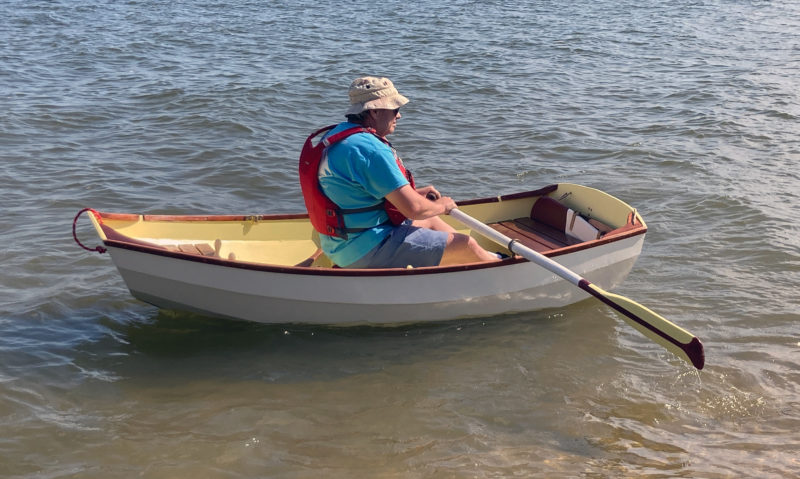 Photo by Audrey and Kent Lewis
Photo by Audrey and Kent LewisWith a single occupant aboard, the Nutshell sits with the bow transom clear of the water without a lot of overhang shortening the hull’s waterline.
A sculling notch is placed top center of the transom. We are not experienced scullers, but for 40 years Maynard has used his Nutshell to get to and from his boat in a crowded mooring and sculls it almost exclusively.
Sailing the Nutshell is delightful! The daggerboard trunk is offset to starboard; this preserves the uninterrupted length of the keel, which makes it easier to pull the Nutshell onto a dock or a deck. The 37-sq-ft balanced lugsail is set on the lightest mast you’ll ever step, laced to the yard, and set loose-footed on a tiny boom. It is exceptionally easy to rig: one sheet and one halyard, with the halyard secured to a cute belaying pin. The boat draws 1′ 9″ with the daggerboard down and points about as high as you’d expect a balanced lug to point, which is not especially high, but sails well through all other points of sail. Jibes are easy to control, and the tiny boom isn’t likely to do too much damage to the noggin of a skipper who fails to duck. The Nutshell is well suited for junior sailors, yet it has room for two adults to sail comfortably. The pram can be sailed from the aft or middle seat, or the bilge, and when sitting in the bilge the sides of the boat provide comfortable backrests—almost too comfortable if one wants to stay awake. The plans include a way to make the middle thwart removable to free up space for the solo sailor to move closer to the daggerboard trunk to balance the boat fore and aft, although we found it fun to sit a bit aft to raise the bow and spin the pram around in pirouettes on its stern.
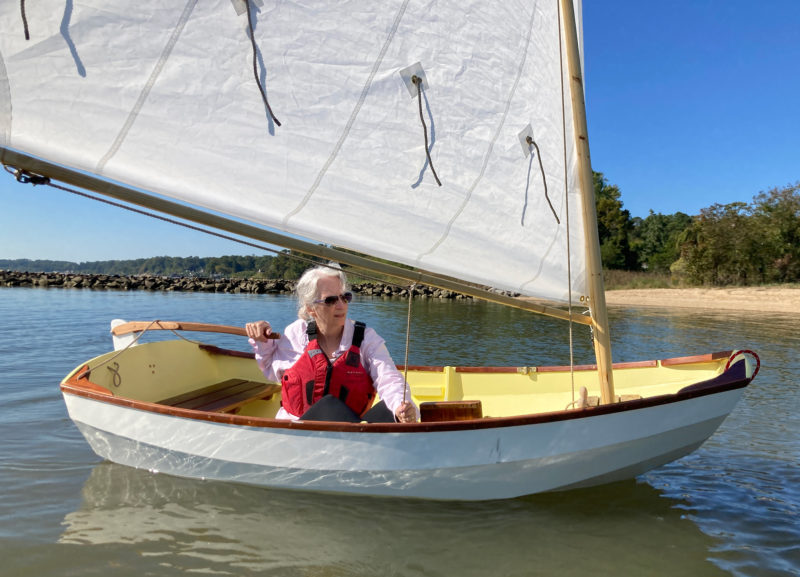 Photo by Audrey and Kent Lewis
Photo by Audrey and Kent LewisThe Nutshell comes with an option for a removable center thwart. Here is has been removed from its position aft of the daggerboard trunk to give the sailor more room. Sitting on the bottom of the boat puts the boat in proper trim and gives the tiller its full range of motion.
Joel gave the Nutshell a shape that rides well under tow; the angled bow transom and the V sections of the garboards below it ride over waves easily, and the full-length keel keeps it towing straight. The painter is led through a hole in the bow transom and secured to the laminated fore keel. For towing the sailboat version of the pram, the daggerboard trunk must be plugged to prevent water from spouting through it and swamping the pram. Maynard’s book shows a short board to fill the trunk and a gasketed cap to seal the opening; a pin keeps it in place with the gasket pressed tight.
The rudder hardware has a single long pintle supported by two flanges. The gudgeon set low on the rudderstock is split to engage the long middle section of the pintle when the rudder is held horizontally, then capture it when the rudder is rotated upright. When the rudder slides down on the pintle, the top gudgeon can slip over the short top extension of the pintle. This arrangement allows the rudder to be easily installed while reaching over the stern of a bobbing boat. If the bottom of the rudder hits an obstacle or bottoms out during beaching, the rudder can rise along the pintle and, if the top gudgeon comes free, a tether will ensure that the rudder is not lost overboard. When the sailing rig is dropped for rowing, the daggerboard, rudder, and tiller stow nicely in the gap between the transom and the aft thwart.
 Photo by Audrey and Kent Lewis
Photo by Audrey and Kent LewisThis Nutshell’s sail has a row of reef points, described in Maynard Bray’s book as “a prudent step.” He also advises “Hold the sheet; don’t belay it. Being able to instantly let it go in a puff will avoid a capsize.”
The uncluttered interior simplifies cleaning, varnishing, and painting. There are not a lot of nooks and crannies to conceal dirt and water. However, the space under the mast partner needs to be peeked at and kept clean and dry when in storage.
The Nutshell takes up little storage space and it is extremely portable. We keep ours on a dolly and use our utility trailer to haul it to beaches with ramps so we can access skinny water. Cartopping is also a practical option that offers up additional launch sites that can’t accommodate trailers. The 7′ 7″ × 4′ footprint will fit in the bed of a standard pickup truck, even one with the short bed popular today.
The Nutshell Pram has classic looks, is small, simple, and affordable, provides refreshing relief from the complexity of larger boats, and does the job for which it was designed exceedingly well. We join Maynard in believing that the Nutshell Pram is Mr. White’s best design. Thousands of Nutshells were built during the first decade of the design being offered. “Can’t beat ’em,” Maynard says. ![]()
Kent and Audrey Lewis named their Nutshell EXCUSE ME; the pram will seek prizes in the waters of Hampton Roads. Its build log and adventures are found at Small Boat Restoration. They wish to thank to Maynard Bray and Eric Dow for sharing their extensive knowledge of the history, care, and feeding of the Nutshell Pram.
Nutshell Particulars
[table]
Length/7′ 7″
Beam/4′
Draft, board up/5″
Draft, board down/1′ 9″
Weight/approx. 90 lbs
Sail area/37 sq ft
[/table]
The WoodenBoat Store offers Nutshell plans ($75), kits (rowing version $2,500, sailing $3,000), rudder hardware ($154), Bray’s Building the Nutshell Pram, as well as sails and rowing and sailing hardware kits. The same items are available for a 9′6″ version of the Nutshell.
Is there a boat you’d like to know more about? Have you built one that you think other Small Boats Magazine readers would enjoy? Please email us!
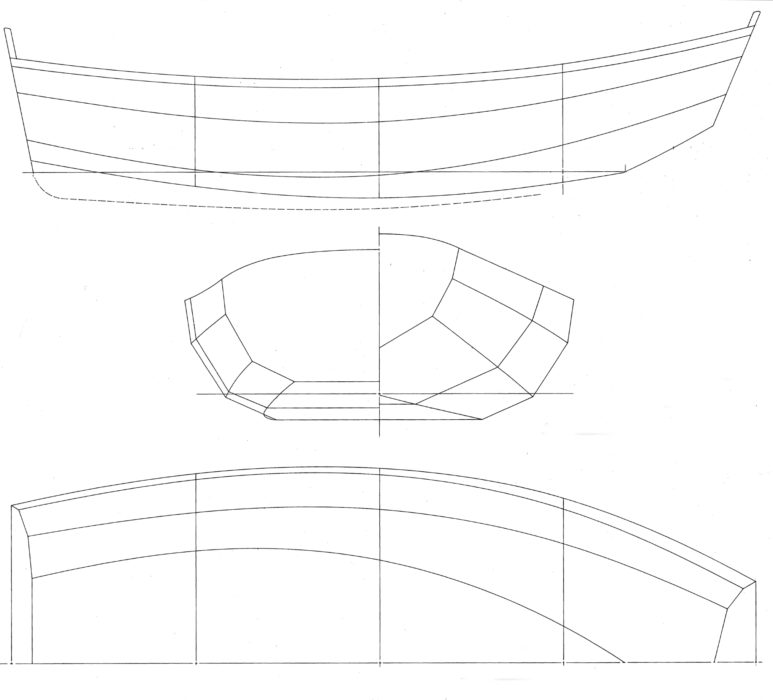

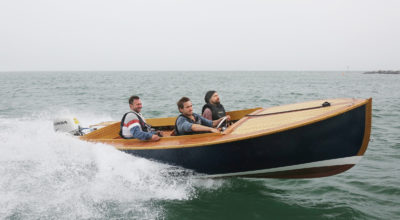
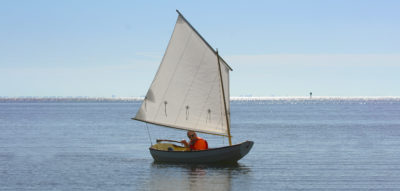


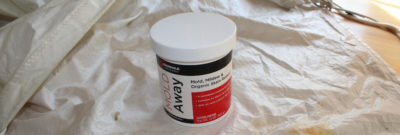
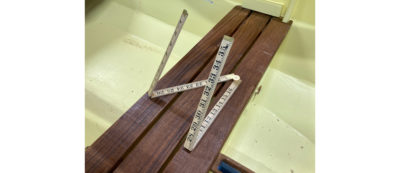
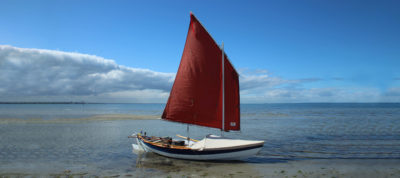
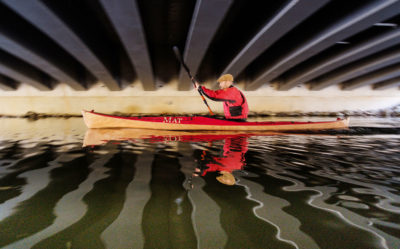


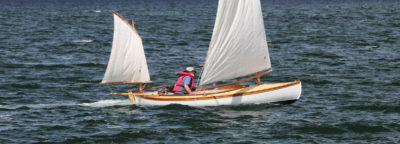
An interesting article, I’ve been fortunate enough to have followed the build of the Nutshell Praam EXCUSE ME via emails from Kent and Audrey (Skipper).
The build reminded me of the Yealm Praam that I built as a tender to the Wooden Drascombe Lugger SAGA. The Yealm Praam was scratch built without any plans at all, it was all done by eye and the length dictated by a standard 8ft x 4ft sheet of marine plywood. A nice varnished finish impressed the owner’s wife, who upon seeing it for the first time declared “It has a better finish than my sideboard.”
For those who may not know, Doug and his brother John built most of wooden Drascombes under licence from John Watkinson. It’s on my Bucket List to try and replicate a Yealm Praam with Doug’s approval and guidance.
Kent
Please feel free to have a go, but you’ll need to remember that I had no plans whatsoever, I don’t have any records of the measurements, not even the length and beam, apart from it being the maximum length that an 8′ x 4′ sheet of marine plywood allowed. I can of course provide a step by step process list and a good guess at the beam and freeboard.
Does the Nutshell pram need lofting to build?
Hi Richard
Full size patterns are included with the plans for the molds, transoms, forekeel and amidships keel. The 8 page plans have a sheet dedicated to plank layout that gives sufficient measurement points to trace and draw out the bottom and side planks. There is also a page with lines and offsets but we didn’t have to refer to that very much. Happy to answer any other questions that you may have.
Cheers
Skipper and Clark
If she’s anything like my Shellback, she’s a keeper. $3000 for the kit? A bit over the top.
Hi Rob
Yes, Fall 2022 prices are startling. Pandemic pricing increase due to logistics chain and workforce isolation issues was bad enough, now throw in the Russo-Ukranian war effect on the World economy. If memory serves correct the rowing kit was around $1750 pre-pandemic, not sure what the sailing kit was. In early 2022 we bought our high quality marine grade sapele plywood, mahogany and teak hardwood from World Panel in North Carolina, plus the Sailrite sail kit and paid close to $1500 in those purchases, including the 2-hour drive time each way to World Panel. 2×4 spruce for spars, and not the good stuff, is still almost double the pre-pandemic price. The kit will have the highest quality materials so the builder’s decision comes down to 1) whether quality materials can today be sourced locally for a significantly lower price and/or 2) Does the builder have the skill/tools to cut that expensive material?
Our advice for first time builders, not those who are already well versed in wood boat butchery like us, is to look closely at a kit purchase to flatten the learning curve.
Cheers
Clark and Skipper
An interesting bit of trivia, the design didn’t have a type name, but one of the first buyers named hers “Nutshell” because of the shape. It stuck.
I built mine from scratch. I had never built a boat before, nor even sailed, yet I was able to make it from the plans. Sometimes I felt I was out of my depth, particularly as all the measurements are in feet and inches, and in Australia we use the metric system and all materials are sold in metric. Other than that, I prevailed to a completed sailing version.
It’s a great little boat.
Phil Bolger designed at least one boat using metric measures. He advocated metric as a superior system. Do school kids trained in metric even need to learn fractions?
My favorite rowing boat. Thinking of the 12’ version, Passagemaker
I am curious about the sailing characteristics of the wood peanut class? I am not thinking of racing I am thinking of what happens in a capsize event from a novice sailor or a heavy wave from a passing motor boat?
Does the boat lie horizontal on the water or turtle? How much water is in the boat after righting?